
The Ajanta Caves are approximately 30 rock-cut Buddhist cave monuments which date from the 2nd century BCE to about 480 CE in Aurangabad district of Maharashtra state of India. The caves include paintings and rock-cut sculptures described as among the finest surviving examples of ancient Indian art, particularly expressive paintings that present emotions through gesture, pose and form.
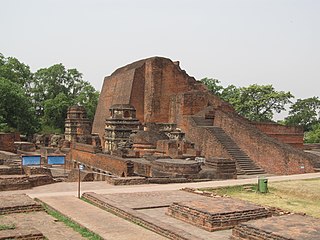
Nalanda was an ancient Mahavihara, a revered Buddhist monastery which also served as a renowned centre of learning, in the ancient kingdom of Magadha in India. The university of Nalanda obtained significant fame, prestige and relevance during ancient times, and rose to legendary status due to its contribution to the emergence of India as a great power around the fourth century. The site is located about 95 kilometres (59 mi) southeast of Patna, and was one of the greatest centres of learning in the world from the fifth century CE to c. 1200 CE. Today, it is a UNESCO World Heritage Site.

Sarnath is a place located 10 kilometres north-east of Varanasi near the confluence of the Ganges and the Varuna rivers in Uttar Pradesh, India. The Deer Park in Sarnath is where Gautama Buddha first taught the Dharma, and where the Buddhist Sangha came into existence through the enlightenment of Kondanna.

Sanchi is a Buddhist complex, famous for its Great Stupa, on a hilltop at Sanchi Town in Raisen District of the State of Madhya Pradesh, India. It is located in 46 kilometres (29 mi) north-east of Bhopal, capital of Madhya Pradesh.
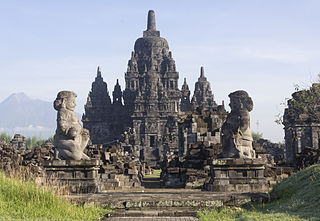
A Buddhist temple or Buddhist monastery, is the place of worship for Buddhists, the followers of Buddhism. They include the structures called vihara, chaitya, stupa, wat and pagoda in different regions and languages. Temples in Buddhism represent the pure land or pure environment of a Buddha. Traditional Buddhist temples are designed to inspire inner and outer peace.
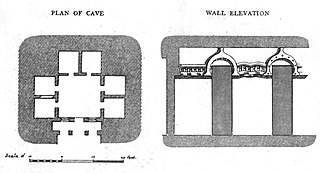
Vihara generally refers to a monastery for Buddhist renunciates. The concept is ancient and in early Sanskrit and Pali texts, it meant any arrangement of space or facilities for dwellings. The term evolved into an architectural concept wherein it refers to living quarters for monks with an open shared space or courtyard, particularly in Buddhism. The term is also found in Ajivika, Hindu and Jain monastic literature, usually referring to temporary refuge for wandering monks or nuns during the annual Indian monsoons. In modern Jainism, the monks continue to wander from town to town except during the rainy season (Chaturmas), the term "vihara" refers their wanderings.

A chaitya, chaitya hall, chaitya-griha, refers to a shrine, sanctuary, temple or prayer hall in Indian religions. The term is most common in Buddhism, where it refers to a space with a stupa and a rounded apse at the end opposite the entrance, and a high roof with a rounded profile. Strictly speaking, the chaitya is the stupa itself, and the Indian buildings are chaitya halls, but this distinction is often not observed. Outside India, the term is used by Buddhists for local styles of small stupa-like monuments in Nepal, Cambodia, Indonesia and elsewhere. In the historical texts of Jainism and Hinduism, including those relating to architecture, chaitya refers to a temple, sanctuary or any sacred monument.

Moinamoti is an isolated low, dimpled range of hills, dotted with more than 50 ancient Buddhist settlements dating between the 8th and 12th century CE. It was part of the ancient Tripura division of Bengal. It extends through the centre of the district of Comilla in Bangladesh. Moinamoti is located almost 8 miles from the city of Comilla. It is the home of one of the most important Buddhist archaeological sites in the region. Comilla Cantonment is located nearby and houses a beautiful colonial era cemetery. Mainamati is named for the Chandra queen of the same name, mother of Govindachandra. Mainamati is 114 kilometers from Dhaka city through National Highway 1 and is nearly 162 kilometers from Chittagong. Also, there is a Buddhist temple beside it.
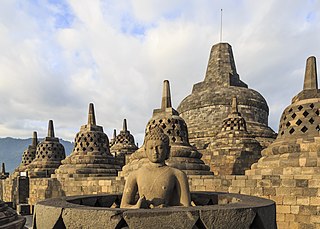
Buddhist religious architecture developed in the Indian subcontinent. Three types of structures are associated with the religious architecture of early Buddhism: monasteries (viharas), places to venerate relics (stupas), and shrines or prayer halls, which later came to be called temples in some places.

Piprahwa is a village near Birdpur in Siddharthnagar district of the Indian state of Uttar Pradesh. Kalanamak rice, a scented and spicy variety of rice is grown in this area. It lies in the heart of the historical Buddha's homeland and is 12 miles from the world heritage site of Lumbini that is believed to be the place of Gautama Buddha's birth.

Bhaja Caves is a group of 22 rock-cut caves dating back to the 2nd century BC located in the city of Pune, India. The caves are 400 feet above the village of Bhaja, on an important ancient trade route running from the Arabian Sea eastward into the Deccan Plateau. The inscriptions and the cave temple are protected as a Monument of National Importance, by the Archaeological Survey of India per Notification No. 2407-A. It belongs to the Hinayana Buddhism sect in Maharashtra. The caves have a number of stupas, one of their significant features. The most prominent excavation is its chaitya, a good example of the early development of this form from wooden architecture, with a vaulted horseshoe ceiling. Its vihara has a pillared verandah in front and is adorned with unique reliefs. These caves are notable for their indications of the awareness of wooden architecture. The carvings prove that tabla – a percussion instrument – was used in India for at least 2300 years, disproving the centuries-held belief that the tabla was introduced to India by outsiders or from Turko-Arab. The carving shows a woman playing tabla and another woman, performing dance.
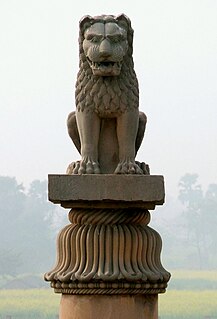
Vaishali or Vesali was a city in present-day Bihar, India, and is now an archaeological site. It is a part of the Tirhut Division.

Somapura Mahavihara in Paharpur, Badalgachhi Upazila, Naogaon District, Bangladesh is among the best known viharas, centres of learning, in the Indian Subcontinent and is one of the most important archaeological sites in the country. It is also one of the earliest sites of Bengal, where significant numbers of Hindu statues were found. It was designated as a UNESCO World Heritage Site in 1985. It is one of the most famous examples of architecture in pre-Islamic Bangladesh. It dates from a period to the nearby Halud Vihara and to the Sitakot Vihara in Nawabganj Upazila of Dinajpur District.

Shalban Bihar is an archaeological site in Moinamoti, Comilla, Bangladesh. The ruins are in the middle of the Lalmai hills ridge, and these are of a 7th-century Paharpur-style Buddhist Bihar with 115 cells for monks. It operated through the 12th century.
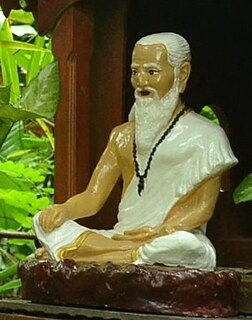
Jīvaka was the personal physician of the Buddha and the Indian King Bimbisāra. He lived in Rājagṛha, present-day Rajgir, in the 5th century BCE. Sometimes described as the "Medicine King", he figures prominently in legendary accounts in Asia as a model healer, and is honoured as such by traditional healers in several Asian countries.

The Amarāvatī Stupa, popularly known as the great stūpa at Amarāvathī, is a ruined Buddhist monument, probably built in phases between the third century BCE and about 250 CE, at Amaravathi village, Guntur district, Andhra Pradesh, India. The site is under the protection of the Archaeological Survey of India. The campus includes the stūpa itself and the Archaeological Museum.

Kantharodai Viharaya is an ancient Buddhist temple situated in Chunnakam, Jaffna District, Sri Lanka. The temple is located in a small hamlet called Kandarodai and it is one of the few Buddhist temples remaining in Jaffna today. Currently this temple has been declared as an archaeological site in Sri Lanka.

Devnimori, or Devni Mori, is a Buddhist archaeological site in northern Gujarat, about 2 kilometres (1.2 mi) from the city of Shamlaji, in the Aravalli District of northern Gujarat, India. The site is variously dated to the 3rd century or 4th century CE, or circa 400 CE. Its location was associated with trade routes and caravans in the area of Gujarat. Site excavations have yielded Buddhist artifacts dated prior to 8th-century in the lowest layer, mixed Buddhist and Hindu artwork from the Gurjara-Pratihara period in the middle, topped by Muslim glazed ware attributed to the 14th century. The site was excavated between 1960 and 1963. The site became flooded by the Meswo reservoir, a project started in 1959 and completed over 1971-1972 over the nearby Meshwo River.

The Buddhist caves in India form an important part of Indian rock-cut architecture, and are among the most prolific examples of rock-cut architecture around the world. There are more than 1,500 known rock cut structures in India, out of which about 1000 were made by Buddhists, 300 by Hindus, and 200 by Jains. Many of these structures contain works of art of global importance, and many later caves from the Mahayana period are adorned with exquisite stone carvings. These ancient and medieval structures represent significant achievements of structural engineering and craftsmanship.

Ancient Indian architecture is the architecture of the Indian subcontinent from the Indian Bronze Age to around 800 CE. By this endpoint Buddhism in India had greatly declined, and Hinduism was predominant, and religious and secular building styles had taken on forms, with great regional variation, which they largely retained until and beyond the great changes brought about by the arrival of first Islam, and then Europeans.


























